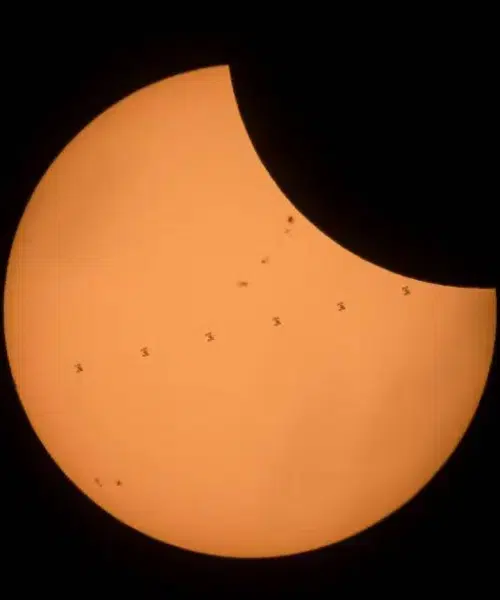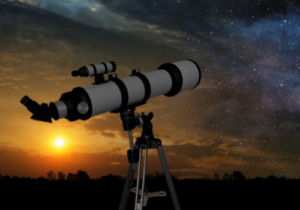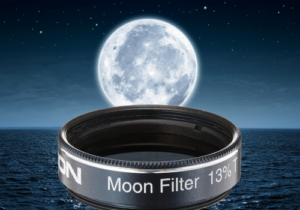Can You See The ISS With A Telescope? 5-Minute Read
Disclosure: This post contains affiliate links and I may earn a small commission (at no extra cost to you) if you click through and make a purchase. Thanks in advance – I really appreciate it!
As a teenager when I learned that the ISS orbits the Earth every 90 minutes and it’s only 248 nautical miles above the Earth’s surface, I could not wait to observe it in great detail with my 8” reflector telescope.
Key Takeaways:
Can you see the ISS with a telescope?
ISS can be seen with a telescope using a low-power eyepiece that gives the most amount of telescopic field of view. However, it’s very difficult to follow the ISS with a telescope as it moves very quickly across the sky. It’s easier to track and observe the ISS with a pair of binoculars.
If you’re someone who wants to see the ISS (International Space Station) in all its glory, with or without the telescope, then this article is for you.
In this article, I will explain in detail how you can observe the ISS with a telescope, the challenges that come along with it, and the best way to view the ISS from Earth.
We will also discuss how you can find out if the ISS is going to be visible in the sky tonight, wherever in the world you may be living.
Can You See The ISS With A Telescope
The International Space Station can be viewed from various locations around the planet. It is easily spotted, as it is the third brightest object that appears during nighttime, after the Moon and Venus.
You can also view the ISS with your naked eyes while it moves across the sky at thousands of miles per hour.
Later in this article, we will discuss how you can view the ISS just with your naked eyes or with a pair of binoculars, but first, let’s find out a little bit more about the ISS and how you can view it using a telescope.
What is the ISS?
The ISS or the International Space Station is an internationally operated, habitable artificial satellite in low-earth orbit. It is jointly operated by the United States (NASA), Russia (Roscomos), Japan (JAXA), Canada (CSA ASC), and the European Space Agency (ESA), and is governed by treaties between these nations.
The ISS flies at an average altitude of 248 miles (400 kilometers) above Earth. It circles the globe every 90 minutes at a speed of about 17,500 mph (28,000 km/h).
In one day, the station travels about the distance it would take to go from Earth to the moon and back.
The ISS is visible every day to amateur astronomers from the earth’s surface with the naked eye, binoculars, or with a telescope.
To be able to see ISS passing the sky requires you to know when and where to look up, which we will discuss later in the article.
What does ISS look like from the Earth?
The ISS is visible from the Earth and it appears like a bright star in motion, one of the brightest objects in the sky, roughly the luminosity of Venus and more visible than Jupiter. The ISS might resemble a plane, but notice the constant movement with no flashing lights as it grows brighter.
From the earth’s surface, the ISS orbit appears to be a floating white dot that moves across the sky after sunset and just before sunrise, when the sun’s light is still on the station but not the earth below it.
As the years have passed, the ISS has become larger and larger as upgrades were added, and thus, it became even brighter as well. It isn’t so difficult to spot the ISS since you will recognize it quickly.
The only thing you need to know is when to look for it, as it is visible at specific points in time while it passes through your location.
Weather permitting, it can be spotted from 95% of the earth’s surface, it is not visible from the northern or southern poles but can be seen from every other location.
During the 2017 total solar eclipse, some photographers traveled to the middle of Wisconsin in the United States so they could witness the ISS transit the sun during a partial phase of the solar eclipse.

The International Space Station passing in front of the partially eclipsed sun. (Photo Credit: NASA/Joel Kowsky)
How To See The ISS With A Telescope
The ISS is the biggest object made by man to drift across space and it can be viewed from wherever around the globe, under the right circumstances of course.
Moreover, it is one of the easiest objects in the sky to be found, even without a telescope. It is highly reflective and brighter than Venus and its size is similar to Jupiter, but the only problem is that it moves very quickly and you can miss it fast.
Basically, the ISS is visible because it reflects the light of the Sun, which is also the reason why we can see the Moon.
The ISS always appears in the western sky first and travels east. Look for a bright, pale yellow star, with a steady light.
Here’s how you can observe the ISS with a telescope.
- Use a low-power eyepiece, the best would be to use an eyepiece with a magnification of 65x. A low-power eyepiece will provide you with a wide field of view.
- Place your telescope on a mount and align your finder. Use a low-power finderscope and aim the finder at the ISS and note its direction of travel.
- Set the crosshairs at the spot you anticipate the station to reach in a few seconds and quickly return to the eyepiece.
- With the space station in view, move the telescope along to follow, keeping the ISS centered in the field of view as best you can.
You may not succeed at the first couple of attempts, but I suggest that you keep trying and soon you will be able to anticipate its timing better.
Also, with practice, you will become better at tracking and following the ISS as it quickly traverses across the sky.
Keep in mind that, the greater the magnification, the harder it is to see the ISS because it moves fast, and it is hard to track.
The perfect moment to spot the ISS is when it is rising above the horizon because that’s when it will be most fully illuminated by the Sun, and visible for several minutes.
RELATED: What Are the Dimmest Stars You Can See With a Telescope
Below is a video that might help you set up your telescope to get the best view of ISS.
Can a GoTo Telescope Track the ISS?
The ISS can be tracked using Celestron’s GoTo telescopes using a program called the Optic Tracker. A joystick is used to acquire a moving target. Once the imaging software “locks” on a target, it will keep the scope moving in the same direction automatically.
This program can be used to track any rapidly moving sky targets such as an aircraft or a number of satellites.
Below is a video depicting how ISS will look like through a telescope.
Is ISS Visible Tonight?
Whether or not the space station will be visible on a given day depends on its orbit and at what time of day it passes overhead.
Several websites and smartphone applications will provide users with all the information they need should they choose to view the space station. Based on the user’s longitude and latitude, such tools can give users information regarding:
- When the ISS will be visible in local time.
- Where it will appear to rise.
- The altitude above the horizon the station will reach.
- The duration of visibility before the station enters the Earth’s shadow.
Additionally, starting in 2012, NASA began offering text and email alerts to subscribers who wanted to “Spot the Station” when it appeared over their hometown.
Here are a few tools to help you know how and when to see the International Space Station:
- NASA’s Spot the Station tool and app.
- Heavens-Above
- ISS Spotter – Free for iPhone.
- ISS Detector – Free for Android.
- Satellite Tracker – From Sky & Telescope.
Written by:

Kavya Joshi
My love affair with space began in a field in India at the age of 7, when I looked up at the Milky Way for the first time. Ever since, I have been attempting to cram in every fact about the Universe, I can find into my head.
ABOUT US
We are a team of active amateur astronomers, here to help you with all your astronomy and science related needs – this is anything, from reviewing the latest telescopes to be released to talking about gravity and neurons. The Big Bang Optics was started because of our love for astronomy and to help others like us find the best telescope and accessories.
LEGAL DISCLAIMER
The Big Bang Optics is a participant in the Amazon Services LLC Associates Program, an affiliate advertising program designed to provide a means for sites to earn advertising fees by advertising and linking to Amazon.com. The Big Bang Optics also participates in affiliate programs with Clickbank and other sites. The Big Bang Optics is compensated for referring traffic and business to these companies.




